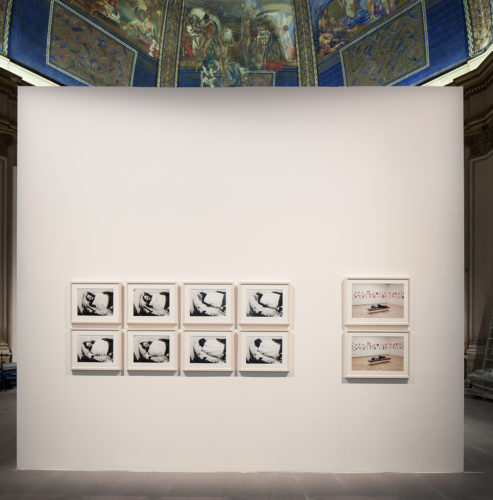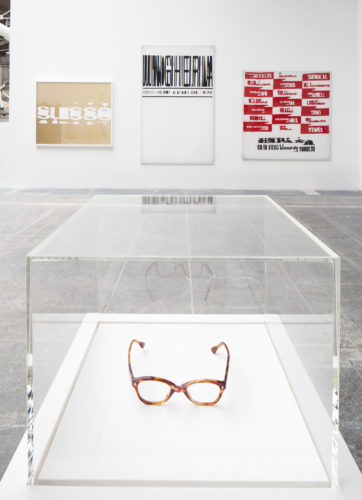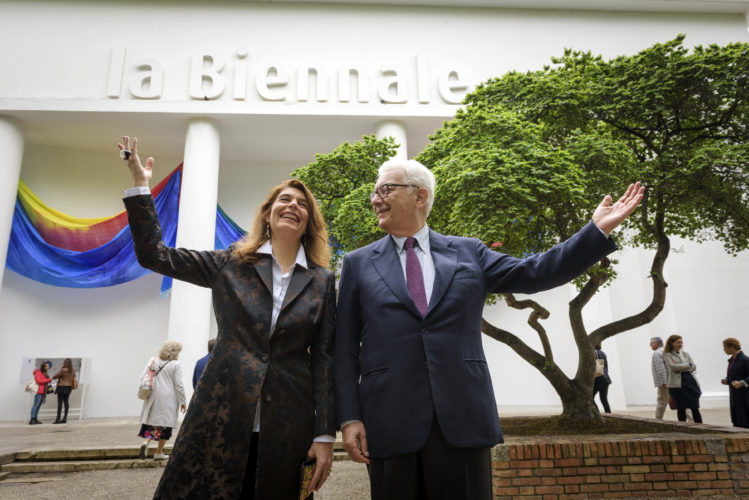Ebb and flow, Viva Arte Viva (2017), after All the World’s Futures (2015). Seen through the lens of critical theory, the current Venice Biennale easily lends itself to be read as “reactionary,” as a gesture of neutrality, or, worse, of political neutering. Have we reached a point where we celebrate redundant vitalism, which turns its back to the “angel of history”?
Refraining from any hasty labeling, we must admit though that, while Okwui Enwezor placed the 2015 edition under the sign of Benjamin’s theses on the philosophy of history, calling for “a fresh appraisal of the relationship of art and artists to the current state of things,” the concept proposed by Christine Macel for the 2017 edition assumes a Deleuzian stance. As evidence, we have one of the curator’s statements, extracted from the “official” interview preceding the biennial’s opening: “art is a resistance per se, an alternative in se. And it does not matter if art addresses political issues directly or makes commentaries on the geopolitical situation (…) As Gilles Deleuze used to say, art is not about communication, but it is an act of resistance.”
Christine Macel’s statement references one of Deleuze’s sallies which is often tossed around in the art world, yet which is extricated from the philosophical context of its enunciation, where the “resistance” was directed towards the Habermasian “communicative action” model: “The work of art has nothing to do with communication. Strictly speaking, the work of art doesn’t contain the least bit of information. However, there is a fundamental affinity between the work of art and the act of resistance.”
If we accept the everyday definition of communication as information transmission, but define information like Deleuze as “the controlled system of order-words circulated within a given society,” we start to understand how the “act of resistance” prefigured by the French thinker exhibits a “fundamental affinity” with Foucault’s idea of resistance towards biopolitical normalization. In the same context, the notion of “society of control” was posited explicitly starting from Foucault’s problematizing the modern “apparatus of security” and “society of security.” Therefore Deleuze tried to draw attention to what we may term the modern information “apparatus” (whose plenary character the Web 2.0 “revolution” will bestow upon it) and the way in which it comes to govern the access to knowledge, in our contemporary society. It’s worth here to remember the later Foucault’s “aesthetics-ascetics” counter-conduct, proposed as a solution of resistance, as well as of a vitalist-epistemological problematizing of the inventor’s paralogy in Lyotard’s Postmodern Condition. We see in this sense how the Habermasian model of “communicative action” (like the consensualist understanding of truth) embodies the rationalism of societies of control, the apparatus of power and knowledge characteristic of biopolitical normalization. If we understand the chance art has of placing itself in a register where “language is not always already communication” (Agamben) [1] – meaning before the leveling and “equalizing” that happens, according to Nietzsche, in the fiction of “common” language – we also come to understand the “necessity of speaking” characterizing artistic speech of any kind. The issue is that even this way of talking about art as resistance per se and about resistance through art is a generic one, therefore one that is “common,” public, belonging to everyone and no one. Just as there are personal, individual ways of conforming to social norms, there is also a generic, universal way of talking about resistance to conformism, to normalization, one which risks becoming a surrogate, a stand-in for actual resistance. At this point, the issue of philosophical praxis intersects directly, painfully, and existentially with that of artistic performance. How do we resist?
The concept of resistance which Christine Macel assumes curatorially is an explicitly generic, indeterminate one, just like the idea of “communication” in the oblique attacks by the French poststructuralists against the Frankfurt School tends to be treated unilaterally, Nietzscheanly, and, therefore opposite, in a simple dialectics, to the idea of (art as) resistance (sensus communis vs. dispute, “disoperative” community [2]). Dialectically there is of course some legitimacy and truth to this antithetical positioning of art per se; the problem arises when we remain at this generic, abstract level of conceiving resistance, without further developing this concept in the realm of actual political action. Action then no longer sends to the idea of oeuvre or of expressing an ethos, being reduced to the concept of “promptness” or “effectiveness”: it is the new ontology of action, whose genealogy was outlined by Agamben in Opus Dei. [3] It would mean that anyone from the art world who performs, regardless of how, “resists”; but then what is the effective link with the world “of daily life,” and how can we thus generate, through artistic praxis inserted in an “apparatus of existence” (Bourriaud), a true self-transformation and change in the social reality, which represented the transformative goal of the (neo)avant-gardes?
Dialectical synthesis would require understanding the way in which art communicates, but on a different level. Art is, in other words, communication, but not ordinary communication: the standardized exchange of signs, images, stamped and worn-out words, metaphor coins with their eidos defaced. It would require understanding the way in which art is more than a bridge facilitating the continuous flow of information and goods in the era of financial capitalism. It would mean, in other words, a new recognition of the fact that art represents access to the symbolic order – a two-way bridge, between nature to culture; of that fact that it forwards metaphoric nodes of meaning and social relating that do not lend themselves to containment or exhaustion by any single interpretation.
Let’s not delude ourselves however: the words above articulate just as generic and conventional an answer. An answer that guarantees nothing in terms of value, allowing for imitation, duplication, and imposture. In short, a simulacrum of an answer. And then let’s not forget that the goal of the “pure,” dada avant-garde was exactly to cause the implosion of art as a system of signification, a meaning-assigning machine. [4]
Christine Macel’s pasteurized statement, with generic references to French Theory and with the crossing off the list of every mandatory topic for the preoccupied western intellectual – democracy, resistance to individualism and to the pragmatism and cynicism so prevalent nowadays –, remains, however, conciliatory, therefore non-antagonistic, didactic, and even totalizing.
Such a judgment can be supported by noting some defining aspects of the central exhibition. Firstly, we’ll take note of its spatial quadrillage (as Foucault employs the term in Surveiller et punir): nine Trans-pavilions, reminding one, through their thematic titles, of the popular pre-December 1989 children’s game “Flori, fete sau băieți” [flowers, girls, or boys]. The first is the Pavilion of Artists and Books; the second the Pavilion of Joys and Fears; from the Pavilion of the Common we supposedly learn “the way to build a community, as a way to counter individualism and self-interest”; while, to give one final example, “the Dionysian Pavilion celebrates the female body and its sexuality”!
We then notice the defanging, even neutering of certain neo-avant-garde art actions – such as Stilinović’s 1978 (non)action Artist at Work –, some of which were initially intended as a critique of the idea of an art biennial – see Raymond Hains’s posters –, by recuperating them as retrospective sections within the central exhibition.
I believe an in-depth analysis of this edition’s representative pavilions would highlight the way in which the totalizing – therefore anti-Deleuzian in spirit – curatorial concept reverberates in the national pavilions, only to be found in full in the winning pavilion (Germany’s). I’ll give just one example: the apolitical paradox of Russia’s pavilion, Theatrum Orbis, where the en bloc questioning of capitalism, consumerism, and surveillance, following radical thinkers like Negri and Hardt, enshrouds a potential critique of a certain other capitalism – say, state capitalism under Putin…
When artists are assured that whatever they do as artists is by default a form of resistance, the stakes of resistance itself become doubtful: resistance remains an abstract, undetermined (in a Hegelian sense) concept. What becomes doubtful as well, along with the idea of resistance, is the political character of art, meaning the way in which art relates to the common of public space and to the multiplicity and antagonism (Arendt, Žižek) inherent in political action.
From a dialectical perspective, stating that art is political per se and stating that art is not political per se (existential and political engagement vs. aesthetic autonomy, formalism) are two symmetrical, and therefore equatable, positions. Really, the only resistance per se attributable to the artistic act is towards its entrapment in a single “true” interpretation. To make an artistic gesture however, you must choose, as, quoting Duchamp, “art means to choose.” [5] To choose to resist or to choose to conform to: a style, a trend, an institution, a political order, or the mechanisms of the art market. I fear that most of our choices, both in the art world and in daily life, are not “acts of resistance,” but acts of conformity.
***
Memory is never merely selective: it reframes and, in fact, recreates lived experience. Returning after almost a year to these lines written at the time of the event, I realize that all I wanted in the end was to draw attention to the superficial manner in which many prestigious curators convey philosophical references in their statements and texts. Behind a righteous politico-philosophical indignation there was also an aesthetic discontent: so little fresh life behind this megacelebration of vitality, so many overused formulas… Such an impression does not however invalidate this factual truth: cramming so many works per square meter, the Venice Biennale remains a privileged place to encounter artistic surprises, revelations, and confirmations. We were happy that the Romanian pavilion was for many visitors such a revelation, and for others the confirmation of a great woman artist. But the general problem of the 2017 Biennial was, put simply, that it didn’t even try, utopian as it might be, to please everybody: it simply wanted to not upset anybody, if that’s possible. It isn’t.
It remains to be seen what concept will be proposed by Ralph Rugoff, who has been appointed curator of the 2019 Biennale. On making this announcement, president Baratta insisted, strategically, on the fact that the main purpose of the Biennial is to offer visitors “a direct experience” of art. This sounds like an unremarkable platitude, given the occasion, but it might in fact be a confirmation of a significant turn in the art world: the age of the hermeneutering of aesthetic experience, as Danto named it, is over; the neopragmatist turn in which Western culture is engaged is reorienting artistic production towards the unmediated quality of the experience conveyed to the public, to the detriment of the hermeneutic mediation in which the work constitutes itself. [6] OOO (Object-Oriented Ontology) has gained substantial traction in artistic milieus (more so than in philosophical ones). I can only hope that the ideas of someone like Latour or Harman will not be the targets of subversion similar to what Deleuzian “resistance” went through, namely being taken as grounding for a bifurcated art, pressured to produce exciting experiences for the general public and luxury commodities for the millionaires.
[1] G. Agambern, Ce rămâne din Auschwitz. Arhiva şi martorul, trad. Al. Cistelecan, Cluj-Napoca: Idea Design & Print, 2006, p. 46 [En: Remnants of Awschwitz, Zone Books, 2000].
[2] J.-L. Nancy, La communauté désoeuvrée, Christian Bourgois Editeur, 1986; Comunitatea absentă, trad. E. Cioc, Idea Design & Print, 2005 [En: The Inoperative Community, University of Minnesota Press, 1991].
[3] G. Agambern, Opus Dei. Arheologia oficiului (Homo sacer II, 5), trad. Alex Cistelecan, Cluj-Napoca: Tact, 2016 [En: Opus Dei. An Archaeology of Duty, Stanford University Press, 2013].
[4] P. Sloterdijk, Critica raţiunii cinice. Vol. II, trad. T. Pârvulescu şi S. Munteanu, Iaşi: Polirom, 2003, pp. 198-209 [En: Critique of Cyncal Reason, University Of Minnesota Press, 1988].
Translated by Rareș Grozea.
The short version of this text is published in Revista ARTA #31 in the section titled Geta Brătescu and the Venice Biennale, coordinated by Daria Ghiu.
POSTED BY
Cristian Iftode
Cristian Iftode (b. 1979) is Ph.D. Associate Professor in the Faculty of Philosophy, University of Bucharest, where he teaches courses on ethics, aesthetics and contemporary philosophy. His published ...







Comments are closed here.